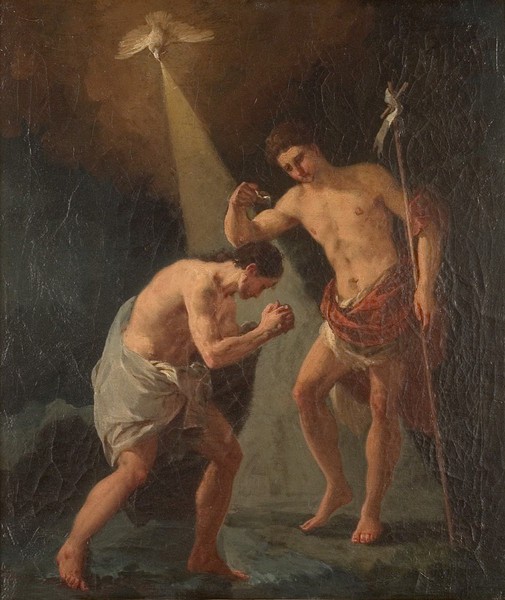- Cronología
- Ca. 1775 - 1780
- Dimensiones
- 45 x 39 cm
- Técnica y soporte
- Oil on canvas
- Reconocimiento de la autoría de Goya
- Documented work
- Titular
- Private collection
- Ficha: realización/revisión
- 06 Jan 2010 / 13 Jun 2023
- Inventario
- -
- Otros títulos:
-
Baptism of Christ in the Jordan (Bautismo de Cristo en el Jordán)
The most common theory is that this piece was intended as a devotional painting for the banker Juan Martín de Goicoechea y Galarza. It was inherited by María Pilar Alcíbar-Jáuregui y Lasauca, the second wife of one of the Counts of Sobradiel, appearing in a family inventory from 1867.
Until July 2022 the artwork belonged to the collection of the Count of Orgaz, month in which it was auctioned and passed to a private collector.
The painting depicts Saint John the Baptist, the supposed recipient's namesake. The image is imbued with a mysticism which moves away from the rococo feel of earlier works to fully embrace the Italianate style which Goya picked up on his travels, evident in the sculptural treatment which gives the two figures an accentuated three-dimensional quality. The two men in the image are clothed in fastened robes. They have been placed on a black background lit up only by the ray of light emanating from the Holy Spirit. At their feet we can make out the blue of the River Jordan.
X-rays have revealed that Christ had been painted kneeling on the floor, his hands positioned lower down than in the final version. A hand had been painted in the upper part of the work, and there was an upside-down head after Giaquinto in the lower left-hand corner.
The painting has evoked differing opinions in terms of dates. Gudiol, Gassier, Wilson and Salas date the work as having been created around 1775-1780, no doubt because of the Italianate echoes in its style. In contrast, Arnaiz is of the opinion that the work can not have been painted any later than 1771-1775, between the artist's return from Italy and his move to Madrid.
The painting was carried out on a surface prepared with a low concentration of glue, which caused extensive spider web craquelure very characteristic of some works by Goya from this period.
This meant that the pigment could easily flake away from the canvas along the edges of the paint islands formed by the cracking. Therefore, the painting was subject to reinforcement and restoration work in the 1980s.
-
Goya joven (1746-1776) y su entornoMuseo e Instituto Camón AznarZaragoza1986consultant editorl José Rogelio Buendía. November 21st to December 20th 1986cat. 38
-
Goya (1746 – 1828)Galleria Internazionale d’Arte Moderna di Ca’PesaroVenecia1989consultant editor Antonio Fortún Paesa. From May 7th to July 4th 1989cat. 12
-
Goya. El Capricho y la Invención. Cuadros de gabinete, bocetos y miniaturasMuseo Nacional del PradoMadrid1993from November 18th 1993 to February 15th 1994. Exhibited also at the Royal Academy of Arts, London, March 18th to June 12th 1994 and The Art Institute of Chicago, Chicago, July 16th to October 16th 1994, consultant editors Manuela B. Mena Marqués and Juliet Wilson-Bareaucat. 3
-
Realidad e imagen. Goya 1746 – 1828Museo de ZaragozaZaragoza1996consultant editor Federico Torralba Soriano. From October 3th to December 1st 1996cat. 18
-
Goya e ItaliaMuseo de ZaragozaZaragoza2008organized by the Fundación Goya en Aragóna, consultant editor Joan Sureda Pons. From June 1st to September 15th 2008cat. 205
-
Goya y Zaragoza (1746-1775). Sus raíces aragonesasMuseo Goya. Colección IbercajaZaragoza2015cat. 23
-
Zaragoza2021
-
Vie et ouvre de Francisco de GoyaParísOffice du livre1970p. 91, cat. 174
-
BarcelonaPolígrafa1970vol. I, p. 253, cat. 114 y vol. II, p. 1
-
L’opera pittorica completa di GoyaMilanRizzoli1974p. 98, cat. 147
-
GoyaBarcelonaCarroggio S.A. de Ediciones1974p. 175, cat. 116
-
Goya. El capricho y la invención. Cuadros de gabinete, bocetos y miniaturasMadridMuseo del Prado1993p. 110, cat. 3 y p. 111 (il.)
-
Goya e Italia, 2 vols.ZaragozaFundación Goya en Aragón y Turner2008vol. II, p. 263, cat. 205
-
Goya y Zaragoza (1746-1775). Sus raíces aragonesasZaragozaFundación Goya en Aragón, Ibercaja y Gobierno de Aragón2015pp. 154-155
-
Goya. Traveler and artist of the Grand Tour (exp. cat.)ZaragozaGobierno de Aragón2021p. 202
